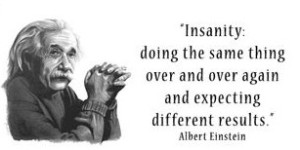There’s an old familiar saying that I’m sure you’ve heard at least once in your lifetime – “you can’t teach an old dog new tricks“. As hokey as it may be, some in our business believe that to be true when it comes to trying to change the views of some of sports talk radio ‘s most familiar voices. Whether it’s a difficult task or not though is irrelevant because change has already begun and listeners are now in control more than they’ve ever been before.
In today’s radio world of PPM measurement, we’ve learned that listeners with meters tune-in often but not for long periods of time. This means they’re looking for a reason to connect with the on-air personalities and the content provided. When it isn’t there, they’ll seek out other options and they’ll waste no time doing so.
 Quite honestly, this is something we’re all guilty of. Our patience is thin, distractions are popping up everywhere and if we’re not engaged immediately then someone else has an opportunity to steal us away. Yet while this becomes a huge challenge for radio broadcasters, I can’t begin to tell you how many shows and hosts I’ve observed over the past few years who think they can keep doing the same thing they’ve always done and have no problem delivering better results.
Quite honestly, this is something we’re all guilty of. Our patience is thin, distractions are popping up everywhere and if we’re not engaged immediately then someone else has an opportunity to steal us away. Yet while this becomes a huge challenge for radio broadcasters, I can’t begin to tell you how many shows and hosts I’ve observed over the past few years who think they can keep doing the same thing they’ve always done and have no problem delivering better results.
What I want to focus on today is what I call the “Dive Right In” approach. In simple terms, this means get right into your content at the start of the segment and don’t waste time.
Sounds simple right? But as you’ll see later on in this piece, not everyone does it and I guarantee you that if you listen to some of the most notable shows and hosts in your market today, you’ll find that they’re guilty of wasting time too.
 To paint a picture for you, think of a professional swimmer. When they walk into the pool area they waste no time diving head first into the water. They don’t stand over the side and dip their toes in to see what the water feels like and whether or not they want to swim in it. They just dive in and start swimming.
To paint a picture for you, think of a professional swimmer. When they walk into the pool area they waste no time diving head first into the water. They don’t stand over the side and dip their toes in to see what the water feels like and whether or not they want to swim in it. They just dive in and start swimming.
Now relate that to the start of a segment on sports talk radio. How many times do you put a show on and hear the personality waste 3-4 minutes of time starting off a segment by talking about what they did during the commercial break, how lovely the weather is outside, what they plan to eat for dinner and what they plan to watch on TV later tonight?
It happens all the time and yet PPM is showing us that we often have listeners at the front of segments coming to us to to consume our programming yet leaving quickly because of our inability to get into the subject matter quickly. It’s a fast paced world and people expect you to deliver content with a purpose and in quick fashion. If you don’t, you’re going to have a tougher time keeping them around.
 I’ve heard some hosts say “sometimes you have to build up momentum, set the scene, relax and then get into things” and that sounds good to the person saying it but for the person consuming the content who wants something good right now and only has a limited amount of time to spend with you, they’re going to tune someone else in who can deliver if you can’t. They’re in control, not us.
I’ve heard some hosts say “sometimes you have to build up momentum, set the scene, relax and then get into things” and that sounds good to the person saying it but for the person consuming the content who wants something good right now and only has a limited amount of time to spend with you, they’re going to tune someone else in who can deliver if you can’t. They’re in control, not us.
Put yourself in the shoes of your audience for a second. You just sat thru a 4-minute commercial break which likely had 6-10 different commercials run. You also consumed one station promo which was likely :30 seconds, sat through a sports update which was 1-2 minutes long and then endured a station liner leading into the segment followed by a music bed.
That is roughly 6-8 minutes of time before the host even opened their mouth to speak and now you’re expecting the listener to wait another 3-4 minutes before you finally offer a great opinion or piece of insight they can’t get anywhere else?
 People are telling us they like our format, our style, our content selection and the presentation of our shows when they give us 2 minutes of time at the start of a segment. What they’re not giving us though is ratings credit that we rightfully deserve but that’s on us because we’re wasting valuable time.
People are telling us they like our format, our style, our content selection and the presentation of our shows when they give us 2 minutes of time at the start of a segment. What they’re not giving us though is ratings credit that we rightfully deserve but that’s on us because we’re wasting valuable time.
We need 5 minutes for their listening to count but we stand no chance of gaining that time if we throw away the start of our segments. To expect a listener to wait 11 minutes before you finally strike gold is foolish. By the time you stumble on to something special, they’ll have changed the channel and missed it.
Rather than just type if out I thought it would be helpful to show some examples so I pulled some audio from a few national shows.
Keep in mind, these personalities and their shows overall are very good. What we’re focusing on here is the urgency of diving into content, not the show in general. Everyone has different approaches and this just highlights some who implement the “Dive Right In” approach and some who don’t.
 Example #1 is from the “Steve Gorman Sports” show on Fox Sports Radio. Click on this link and listen to the start of the 2nd hour.
Example #1 is from the “Steve Gorman Sports” show on Fox Sports Radio. Click on this link and listen to the start of the 2nd hour.
Steve Gorman Sports Podcast Page
When you listen to the audio you’ll find that it takes nearly 1:30 before the show dives into a subject (Byron Scott hired as Head Coach of the Los Angeles Lakers) and once they do, Steve gives his opinion on the hiring, provides some good insight on the story and offers some personal details regarding his growing up a fan of the Lakers during the Showtime era. It’s a popular national topic and they do a solid job with it but waiting 1:30 to attack it is too long. That can often be the difference in a listener being there to consume it or already being on to another station.
Let’s take a listen to another example. This one is of Jorge Sedano filling in on “The Herd“.
 In this example, Sedano wastes no time identifying the subject and gets quickly into his position on it. Instantly as a listener you know it’s a popular subject (Ray Rice suspension) and after sitting thru a long break, you’re given a pay off because Jorge doesn’t make you wait to know where he stands on the story. Overall I thought Jorge executed the approach very well and put himself in good position to gain credit from his audience. Equally as important, it was rewarding for the listener who either stuck around or came back to consume the content.
In this example, Sedano wastes no time identifying the subject and gets quickly into his position on it. Instantly as a listener you know it’s a popular subject (Ray Rice suspension) and after sitting thru a long break, you’re given a pay off because Jorge doesn’t make you wait to know where he stands on the story. Overall I thought Jorge executed the approach very well and put himself in good position to gain credit from his audience. Equally as important, it was rewarding for the listener who either stuck around or came back to consume the content.
So now that we’ve covered Fox Sports and ESPN Radio, let’s take a listen to CBS Sports. Here’s an example from the Jim Rome Show.
 In this example, the music runs :27 seconds before Jim says his first word. Then while he hooks you with a good line “I see this guy working“, the subject focus becomes an email from a listener, followed by another email and then a call and it takes over 3 minutes until we get a strong take from Jim on the Ray Rice material.
In this example, the music runs :27 seconds before Jim says his first word. Then while he hooks you with a good line “I see this guy working“, the subject focus becomes an email from a listener, followed by another email and then a call and it takes over 3 minutes until we get a strong take from Jim on the Ray Rice material.
Getting the audience involved is a good thing and Jim does it as well as anyone but I don’t believe the audience should drive the content, I believe the host should. When Jim delivers opinions they’re usually interesting and entertaining so I’d just prefer to reverse the structure and have Jim set the tone by coming out of the gate red hot with his thoughts and then use the reaction to fuel it further. It puts him more in control of the content direction and if you’ve ever listened to Jim, you know that when he gets going it can be some outstanding radio.
I’ll close up with this last piece of audio and it’s from Colin Cowherd on ESPN Radio. I find this piece fascinating for two reasons. First, he gets right into the material without wasting time. Secondly, the points he raises have a strong connection to the items I’ve raised in this article. Take a listen.
 Colin brings up great points about technology changing everything and people having different expectations today than they did in the past. This is an A.D.D world we’re in and people expect you to grab their attention fast or they’re following Jay-Z’s words and moving “on to the next one“.
Colin brings up great points about technology changing everything and people having different expectations today than they did in the past. This is an A.D.D world we’re in and people expect you to grab their attention fast or they’re following Jay-Z’s words and moving “on to the next one“.
As a host, producer and/or programmer, you should feel encouraged because the passion and interest in your brand of content is strong from the audience. What isn’t as easy though is getting an audience to stick around. If you want to deliver ratings and continue to earn raises and hopefully ratings bonuses, you can’t afford to waste time when people are giving it to you.
If there’s one thing to take away from this article, it’s that it’s not always about whether or not your content is good or your opinions are well thought out. That’s part of the process but getting into things quickly is equally, if not more important. People are impatient and the amount of distractions around them are only going to increase in the future. Help yourself by being prepared, focused and ready to dive right in when your segments start. After all, those who just dip their toes in the water never get to experience the pleasures of swimming in the pool.
Podcast: Play in new window | Download
Subscribe: RSS

Jason Barrett is the Founder and CEO of Barrett Media. The company launched in September 2015 and has provided consulting services to America’s top audio and video brands, while simultaneously covering the media industry at BarrettMedia.com, becoming a daily destination for media professionals. Prior to Barrett Media, Jason built and programmed 95.7 The Game in San Francisco, and 101 ESPN in St. Louis. He was also the first sports programmer for SportsTalk 950 in Philadelphia, which later became 97.5 The Fanatic. Barrett also led 590 The Fan KFNS in St. Louis, and ESPN 1340/1390 in Poughkeepsie, NY, and worked on-air and behind the scenes at 101.5 WPDH, WTBQ 1110AM, and WPYX 106.5. He also spent two years at ESPN Radio in Bristol, CT producing ‘The Dan Patrick Show’ and ‘GameNight’. JB can be reached on Twitter @SportsRadioPD or by email at Jason@BarrettMedia.com.





